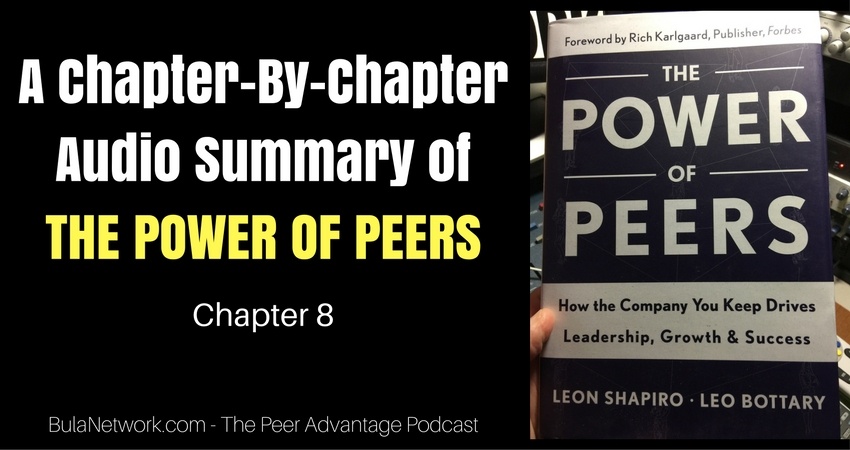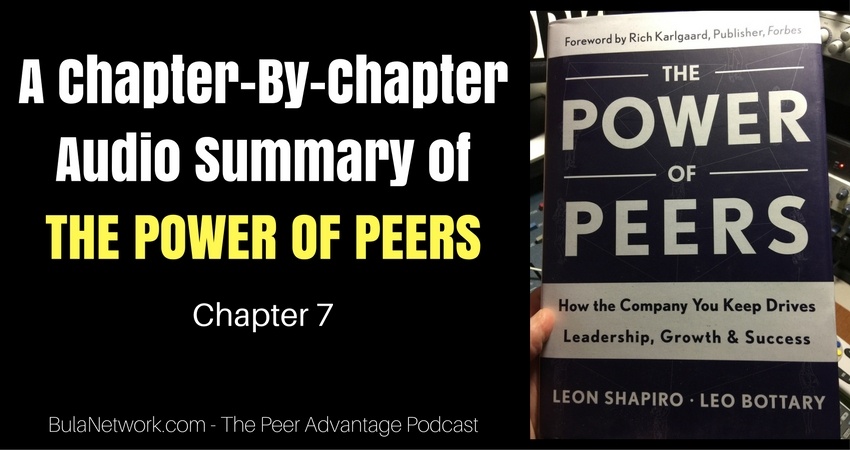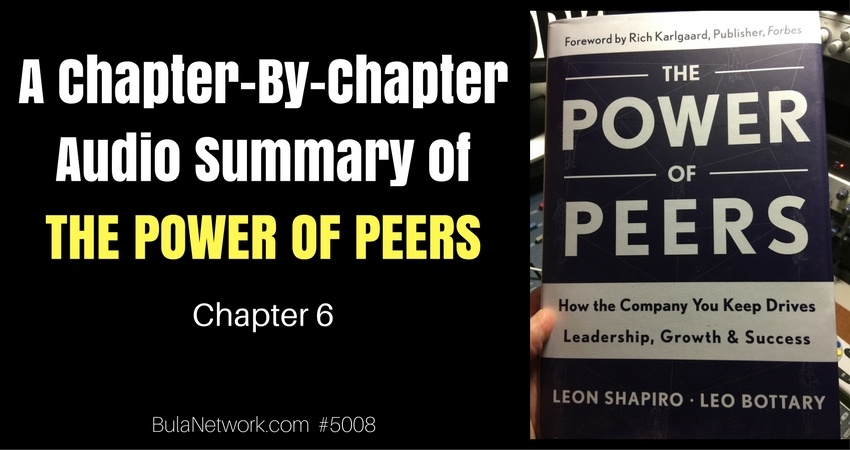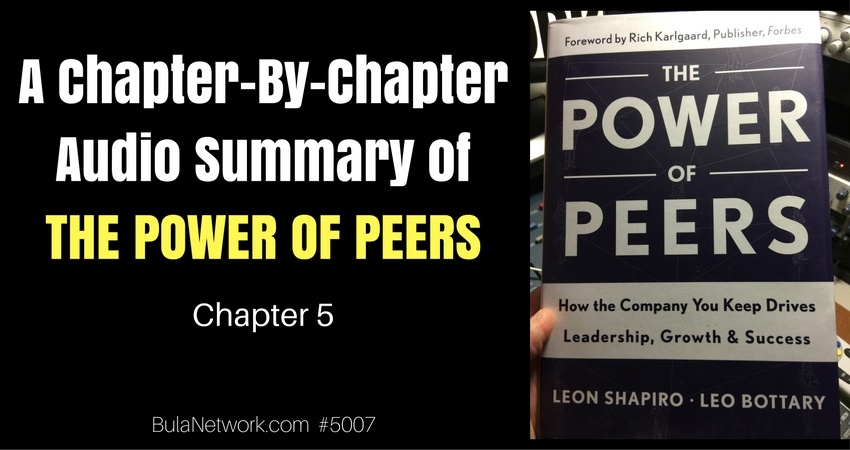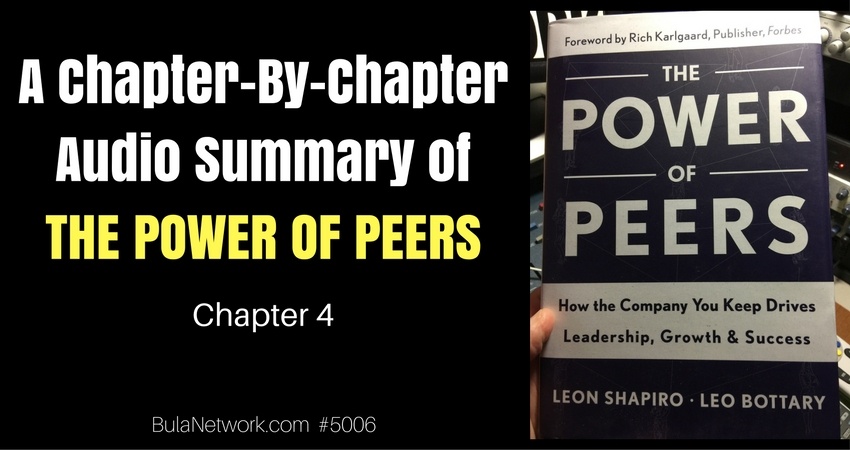A Chapter-By-Chapter Audio Summary Of THE POWER OF PEERS (Chapter 9) #5011
Podcast: Play in new window | Download (Duration: 22:40 — 21.0MB)
Subscribe: Apple Podcasts | Spotify | RSS | More
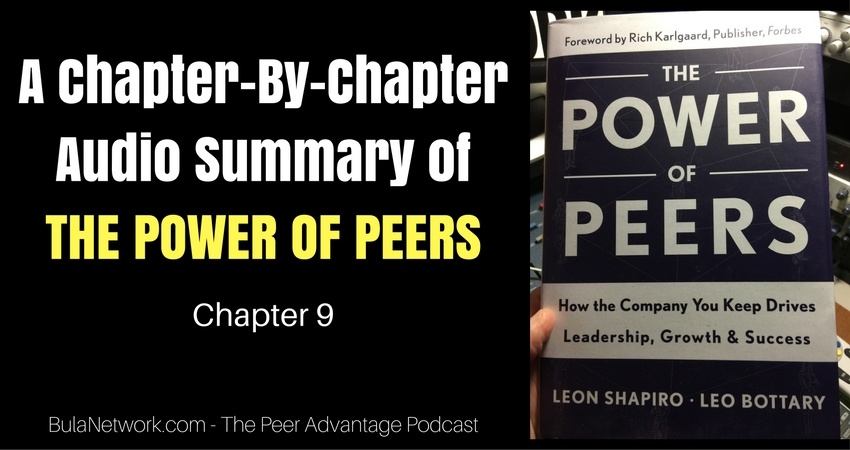
We’re coming toward the end of the book, THE POWER OF PEERS by Leon Shapiro and Leo Bottary. Today we’ll summarize chapter 9, “The Advantage Of Individual Growth.” There are just 3 chapters remaining, including chapter 9.
The chapter begins with the sad, but hopeful story of Jay Steinfeld, the founder and owner of Blinds.com. In 1985 Jay was forced out of his VP of Finance role when his employer was acquired by a multinational company. His wife, Naomi, had started a mom-n-pop drapery and blind business. Together they worked from a storefront and visited customers in their own homes.
Jay launched a website in 1993 that was just an online billboard for the store, but in 1996 he launched an e-commerce site, NoBrainerBlinds.com. A year later Naomi was diagnosed with breast cancer.
She was in and out of remission for a few years. In 2001 the brick and mortar store and the e-commerce site had a handful of employees and both enterprises were equally profitable. Jay was working 6 days a week, then handling paperwork on Sundays. But in 2002 he lost his partner and wife (and mother of their three children).
After 26 years of marriage and a number of years in business together…Jay was alone.
He started reading self-help and philosophy books. He was looking for answers. He learned that his life had been a mixed bag of both pain and happiness.
In 2004 he launched Blinds.com. About a year or so later he realized if he was ever going to grow the company he’d benefit from the advice and help of other business owners or CEOs. So in 2005 he joined a paid peer advisory group.
Jay’s peer advisory group helped him realize he couldn’t do it all. Being CEO did not mean being the Chief EVERYTHING Officer. He knew the blinds business, but he had a lot to learn about being a CEO. Over time his group helped him learn and grow. He worked hard, made the improvements necessary to grow and scale the business at Blinds.com.
What began with a $1500 investment grew over 20 years to become the world’s number one online window covering store with over $150 million in annual revenues. Blinds.com won high praise as a top place in Houston (and in Texas) to work. Jay remarried in 2013, then in 2014 Blinds.com was acquired by Home Depot.
By taking a leap of faith to engage with other business owners and CEOs Jay was able to change his frame of mind and grow. He learned to delegate and focus instead on strategy. He learned with the help of his peer group how to become a CEO. He learned what it meant to be a good (even great) CEO. Ten years later Jay still remains a dedicated member of his CEO peer advisory group.
A good peer advisory group will challenge your worldview, give you pause for reflection and help you develop as a leader while growing as a person.
CEO Groups As A Mechanism For Individual Growth
The authors report that individual growth was a hot button for every peer advisory group leader and member they interviewed. Without individual growth they realized that change and positive outcomes that result from it don’t happen. For growth to happen, individuals have to change who they are and who they are being. It’s about personal transformation.
Generally we hold beliefs about ourselves and about how to survive and thrive in life. Most of these are formed early in our life. Over time, leaders who participate in peer advisory groups begin to identify and recognize those beliefs through their interactions with other members. And members realize that foundational beliefs that once served them may not longer serve them. It’s the beliefs themselves that are self-limiting.
Robert Fritz, known for his study of the way structural relationships impact behavior, believes most of us hold two contrary beliefs that limit our ability to create what we really want — powerlessness and unworthiness. He says he’s only met a handful of people who don’t have one or the other of those beliefs. It’s these beliefs that hold us back no matter what role we serve in an organization. That includes the CEO or owner.
Once peer group members become aware of these and other self-limiting beliefs, they can choose to hold onto them, or to believe something different.
Many CEOs find it valuable to identify beliefs that once served them, but don’t anymore. A peer advisory group can help them face their fears which include the fear of failure, fear of rejection, fear of being wrong, fear of not being in control. Awareness and choices empower us to choose different actions to get different results. Great group members and leaders can observe and offer feedback. It’s sharing perceptions. It’s not about who is right, and who is wrong. It’s identifying how members are showing up in a given situation.
You can’t separate work from personal. Our lives are intertwined. We’re human. There’s no such thing as a purely business issue. With every business issue is some fear, anxiety and risk. And emotion.
All business issues have some personal aspect to them. And all personal issues have the potential to affect you professionally. That’s why personal issues frequently come up in peer advisory groups. CEOs will discuss their challenges with drug addicted children, marriage risks, family members who are dying, grief over the loss of a loved one or a health issue. Just because a person is a leader or owner doesn’t mean they’re immune to the human condition. We all share in life’s problems.
Our natural inclination is to look good in front of our peers. It’s not that we need to look good. It’s that we want to.
We want to share our good sales or profit numbers. We want to share our good news. But when life isn’t so good, we often want to hide. Or downplay it.
The willingness to be vulnerable and bring an issue before the group, good or bad – personal or professional, is where the real value is found. Members can get a 10x to 100x ROI from their group experience. It’s not about tips, techniques or things many might think are most valuable. You can get those, but those may only garner a 3x to 10x ROI. When you operate at the human level and you bring your whole self, you’ll get a much higher ROI from your peer advisory group experience. That’s the way to growth.
The chapter then goes into some details for which they were granted permission to share. Owners and CEOs who credit their peer advisory group with helping them achieve significant growth and success. They tell the story of Jane who took her Texas-based trucking business from $5 million to $25 million because of her commitment to learn and grow. Her group helped her acquire the confidence she lacked when she first arrived. It resulted in helping her hire better and in her willingness to be held accountable. She credits her success to the growth she achieved thanks to her group.
Another story involves a group member who confessed he didn’t have long to live. It was a big moment for everybody in the group as you’d imagine. It was emotional, but it forced every member to consider their own lives. They helped their dying friend through the most difficult time of his life. Members report how it impacted their lives – a lot of personal growth for each of them. Everybody had to get real, look in the mirror and consider their own affairs. Not merely financial and legal affairs, but their personal and relationship affairs.
That same group endured the death of a member’s child. One member’s son died from a drug overdose. Many members had experienced drug addiction in their families. They got through it together.
Then there are the individual stories of CEOs or owners who had to learn to grow into the job with the help of their peer advisory group. CEOs and business owners aren’t necessarily born. We have to learn the skills and mindset necessary for success. Peers can serve to accelerate that learning.
Sometimes we need to learn trust. A story is told of a CEO who, during the economic downturn in 2009, learned (thanks to his group) that his 35-year-old company was 6 weeks away from a cash flow crisis, putting the entire company at risk. About 80 employees relied on the company for their means of support. The CEO had most of his net worth tied up in the company. It was all about to slide off the cliff.
The group pulled together a tiger team (a smaller group of members from within the larger group) together. They literally went into his company at his invitation to help him cut costs…more than he ever though possible. Today, the company is thriving and cash flow positive (massively so). The owner is living a dream life, but he had to transform. He had to trust people. He had to connect. He had to be respectful. When he had first joined the group, he’d had multiple heart attacks. The business had only been marginally profitable. He was an autocratic micromanager.
There are more compelling stories of CEOs and business owners who – thanks largely to their peer advisory groups – learned the things that had previously held them back. From letting go to delegating. From lack of confidence to fear of being wrong. From working all the time to leveraging the work they most enjoy (and were good at). From not believing something was possible to seeing it realized.
Largely the chapter is about members of paid peer advisory groups coming together so each member can learn to overcome the beliefs and ideas that may be holding them back. Much of it is about possibility thinking. We can all use help in seeing the possibility where at first we may have thought it was impossible.
It’s about constant, ongoing learning. It’s about our willingness to constantly question and stretch our thinking, which drives our choices and actions. It’s the truth of the adage that what got us here, won’t get us there.
Growing challenges the bounds of our current thinking. There’s no such thing as personal or business. It’s personal AND business. If you’re open to learning from your colleagues, the first thing you discover is that growing your organization starts with growing YOU. Organizational growth won’t happen without our personal growth. Peer advantage isn’t fully realized without it.
THE PEER ADVANTAGE by Bula Network is designed to help just 14 SMB owners change their lives…and their businesses. These charter members will be able to experience the things depicted in this chapter. Personal, individual growth – which will fuel their business growth. By now you should more easily see the financial return on such an investment. I’ve spent years coaching leaders one-on-one helping them discover the 10x or higher ROI when there are just two of us sitting down together. Let’s put 7 owners together with me serving as the smart guide and it’s not surprise that owners may be able to experience an ROI they never thought possible. As the stories in chapter 9 show us…much of the personal, individual growth is priceless. It’s beyond measurement using decimals or dollar signs. Whether it’s helping a CEO tackle a cash flow problem, or helping a member through the grief-stricken days of the death of a child…the peer advantage is a powerful resource that only the best and brightest seem to fully understand and embrace. I hope you’re among them. Click here if you’d like to apply or learn more.

Subscribe to the podcast
 To subscribe, please use the links below:
To subscribe, please use the links below:
- Click Here to Subscribe via iTunes
- Click Here to Subscribe via RSS (non-iTunes feed)
- Click Here to Subscribe via Stitcher
If you have a chance, please leave me an honest rating and review on iTunes by clicking Review on iTunes. It’ll help the show rank better in iTunes.
Thank you!
A Chapter-By-Chapter Audio Summary Of THE POWER OF PEERS (Chapter 9) #5011 Read More »

